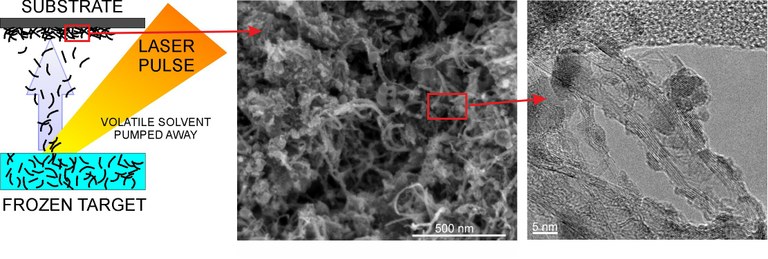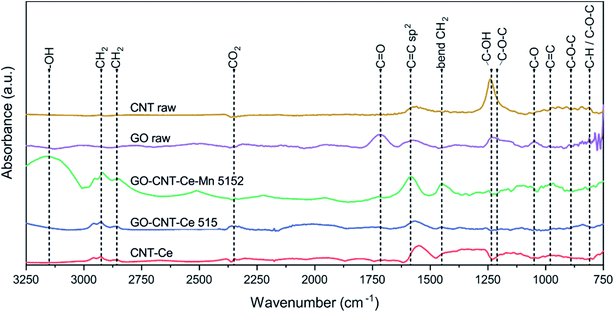
Figure. Reactive inverse matrix assisted pulsed laser evaporation technique was used for the deposition of hybrid composites formed by reduced graphene oxide and carbon nanotubes coated with cerium and manganese oxides. Frozen targets composed of aqueous dispersions of graphene oxide, carbon nanotubes, cerium oxide nanoparticles and manganese-based precursor were exposed to intense UV laser pulses for the electrodes deposition.
Cerdanyola del Vallès, 27 January 2021. The technological advance of portable consumer electronics, wearable medical devices, electric vehicles, smart electric grids and the emerging Internet of Things requires innovation in energy storage technologies. Without doubts, electrochemical energy storage technologies play a major role in this subject.
In particular, supercapacitors are important for their fast and reversible use of energy, high power density, long cycle life, low maintenance cost, and environment-friendly nature.
Novel composite materials are being investigated for improving the energy storage performance of these electrochemical capacitors. For this goal, synergistic effects via the combination of diverse types of materials are crucial.
Researchers from the Institute of Materials Science of Barcelona, ICMAB-CSIC (Spain); the National Institute for Materials Physics (Romania), the ALBA Synchrotron, and the National Institute for Lasers, Plasma and Radiation Physics (Romania), carried out laser deposition of hybrid composites containing reduced graphene oxide and carbon nanotubes coated with cerium and manganese oxides nanostructures, which allowed the versatile fabrication of high-performance supercapacitor electrodes. The obtained devices exhibited high volumetric capacitance and excellent stability after tens of thousands of charge–discharge cycles.
This is the first time a combination of cerium oxide (CeO2) nanoparticles and manganese (Mn) metal organic precursor are used in the laser targets for the synthesis of a hybrid material. The material is based on a synergistic combination of electric double layer nanocarbons and pseudocapacitive metal oxides. The obtained structure led to remarkable increase of the energy storage capability of the electrodes as compared to previous composites based on nickel (Ni) oxide nanoparticles.
The electrodes were fabricated through the reactive inverse matrix assisted pulsed laser evaporation (RIMAPLE) technique, developed at ICMAB-CSIC.
The structure and composition of the obtained materials was carried out by means of Scanning Electron Microscopy – Energy Dispersive X-ray Spectroscopy (SEM-EDX), Transmission Electron Microscopy (TEM), X-ray Photoelectron Spectroscopy (XPS) as well as synchrotron-based Fourier-transform infrared spectroscopy and microscopy (FTIRM) at the MIRAS beamline of ALBA, which allowed a complete study of the organic part of the composite that belongs to the nanocarbon materials.
“These chemical groups present extremely weak signal at conventional FTIR equipment and they remarkably impact on the electrical and electrochemical behavior of the electrode. The FTIR measurements made at MIRAS beamline were able to both identify the chemical bonds and study their spatial distribution along the deposited electrode”, explains Ibraheem Yousef, scientist responsible of the MIRAS beamline.
These composite thin films are of special interest for their application in electrochemical energy storage, particularly in supercapacitors. Moreover, the developed methodology could be also applicable to batteries and chemical sensors.

Figure. SR-FTIRM spectra of samples CNT-raw, GO-raw, CNT-Ce, GO-CNT-Ce 515 and GO-CNT-Ce-Mn-5152.
Reference: Pablo García Lebière, Ángel Pérez del Pino, Guillem Domènech Domingo, Constantin Logofatu, Immaculada Martínez-Rovira, Ibraheem Yousef and Enikö György. Laser fabrication of hybrid electrodes composed of nanocarbons mixed with cerium and manganese oxides for supercapacitive energy storage. J. Mater. Chem. A, 2021, Advance Article. DOI: https://doi.org/10.1039/D0TA06756C




